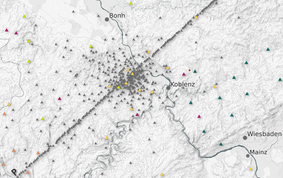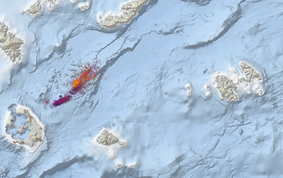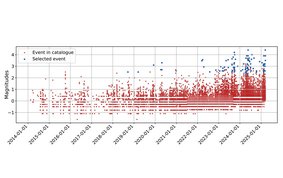Earthquakes, volcanic eruptions, landslides or tsunamis are perceived as suddenly occurring natural hazards that can significantly affect our lives through their impacts and damage. Often, these natural events are at the end of a long chain of processes. In the section Physics of Earthquakes and Volcanoes, we investigate these processes from their formation in the subsurface and their interaction with tectonics, fluid and magma transport, to the monitoring of relevant parameters on the surface and the characterization of individual damaging events and their mechanisms.
To this end, we use and combine approaches from seismology, volcanology, remote sensing and laboratory experiments, and we develop efficient numerical methods for evaluating the different types of data from ground stations, boreholes, drones or satellites. We use state-of-the-art statistical methods to explore precursor processes and improve forecasts.
Our work aims to help society and people to better cope with the many natural hazards and to better understand the geophysical processes in the Earth. To this end, we work closely with scientists at the GFZ, in Germany and internationally, and publish our results and models in high-impact, open-access journals.
Title of the working group: “Physics of Earthquakes”
Working group leader: Prof. Dr. Torsten Dahm
Participating researchers: Dr. Simone Cesca, Dr. Sebastian Hainzl, Dr. Eleonora Rivalta, Dr. Pinar Büyükakpinar, Dr. Daniela Günther, Dr. Gesa Petersen, Dr. Hao Zhang, Patrick Laumann, Angela Carrillo Ponce, Dr. Behnam Maleki
Projects of the working group:
- SURVIVE | Follow the CO2 (ICDP-Eifel): pre-site Survey by Large-N passive seismology
- DEGREE | Digital twin for assessing the exploration potential of geo-resources: Eifel geothermal depth anomaly
- CHASING | Characterizing source properties of NW Bohemia/Vogtland earthquake swarms
- LARGE-N | Volcano seismology experiment in the Eifel
- icdp-EGER | Drilling the Eger Rift
_______________________________________________________
Title of the working group: "Physics of Volcanoes"
Working group leader: Dr. Thomas Walter
Participating researchers: Dr. Daniel Müller, Dr. Edgar Zorn, Benjamin DeJarnatt, Davitia James, Guosheng Gao, Lun Ai, Maria Hurley
Projects of the working group:
Direction Helmholtzstrasse





![[Translate to English:] [Translate to English:] Erdbebenherdprozesse_Logo](/fileadmin/_processed_/e/d/csm_1_Erdbebenherdprozesse_b6cdf32606.png)
![[Translate to English:] [Translate to English:] Modellanpassungen und -prognosen (Kurven mit schattierten Konfidenzintervallen) für Erdbeben mit Magnituden von M > 1,5 (Punkte) im Groningen Gasfeld, Niederlande](/fileadmin/_processed_/b/e/csm_fig4_model_fits_forecast_c111f43f59.png)
![[Translate to English:] [Translate to English:] Vulkan-Tektonik und -Gefahren_Logo](/fileadmin/_processed_/5/a/csm_3_Vulkantektonik_und_Gefahren_92754bdfff.png)
![[Translate to English:] [Translate to English:] Fluid und Magmatransfer](/fileadmin/_processed_/2/a/csm_4_Fluid_und_Magmatransfer_c3bdf933b3.png)
![[Translate to English:] [Translate to English:] Erdbeben-Vulkan Wechselwirkungen_Logo](/fileadmin/_processed_/f/e/csm_5_Erdbeben_Vulkan_Wechselwirkungen_b928b336f6.png)
![[Translate to English:] [Translate to English:] Monitoring_Logo](/fileadmin/_processed_/6/2/csm_6_Monitoring_cd4c7d4684.png)

![[Translate to English:] Susanne Hemmleb (right) and her GEOFON colleague Peter Evans (both Section 2.4) hold the CoreTrus](/fileadmin/_processed_/0/a/csm_cert0677_CoreTrustSeal_Geofon-02_c1e3231982.jpeg)


![[Translate to English:] Map](/fileadmin/_processed_/4/6/csm_Map_ELISE_dfbc556e07.png)
![[Translate to English:] Map Myanmar](/fileadmin/_processed_/b/4/csm_20250328-1300-Slider-01_EarthquakeExplorer-GFZ_eebce5f8ab.jpeg)
![[Translate to English:] picture of Benjamin de Jarnatt](/fileadmin/_processed_/0/5/csm_BenDeJarnatt_IAVCEI_23a3f05131.jpeg)


